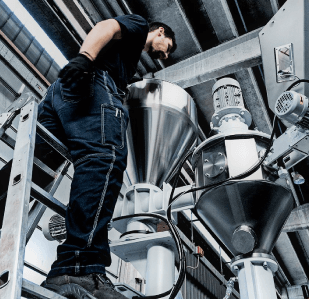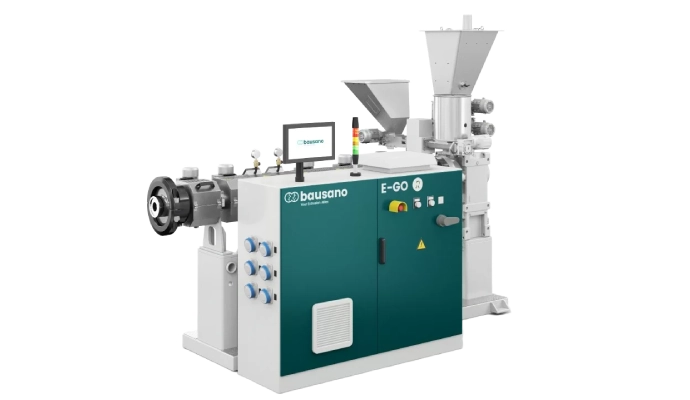In summary
In an era of rising raw material costs and increasing environmental concerns, recycling waste from industrial plastics manufacturing is becoming more valuable than ever. Plastics such as PVC (Polyvinyl Chloride) and Polyolefins (PO) are among the most commonly recycled materials. Urban and industrial waste typically contains a mixture of three main plastic components: low-density polyethylene (LDPE), high-density polyethylene (HDPE), and polypropylene (PP). New extrusion technologies and innovative process designs are crucial to ensuring high-quality recycled products and achieving positive returns on investment.
What Is the Plastic Recycling Process?
Plastic recycling involves recovering plastic waste and transforming it into reusable materials, preserving resources, reducing environmental impact, and minimizing the need for new raw material production. The process varies depending on the type of plastic and its previous application. Let’s explore the key steps involved in the recycling process.
How Is Plastic Recycled?
The plastic recycling process involves a series of critical stages to ensure that the final product is of sufficient quality to be reused in manufacturing. Below are the essential steps:
The first step in recycling plastic is collecting the waste from both industrial and urban sources. Efficient collection ensures a sufficient supply of materials for recycling plants.
Once collected, plastics are sorted based on their type, color, and quality. Mixing incompatible plastics can reduce the quality of the final recycled material.
After sorting, the plastics are washed to remove contaminants like dirt, adhesives, or food residue. Thorough washing is crucial for the purity of the recycled material.
The washed plastics are then shredded into smaller flakes or pellets, reducing their size and making them easier to process during extrusion.
The shredded plastic is heated and melted into a viscous liquid. The melting temperature depends on the type of plastic being recycled.
-
Step 6 - Identification and Classification
Here, polymer types are identified to ensure compatibility. Accurate classification is crucial for consistent product quality.
-
Step 7 - Compounding or Extruding
In the final step, the melted plastic is processed into new shapes or forms, such as pellets, ready to be used for creating new products. Extrusion technologies play a vital role in the quality of recycled material.
Types of Recycling
Plastics can undergo mechanical or chemical recycling, each offering different advantages.
Mechanical recycling involves grinding, melting, and reforming plastics into new products. It is cost-effective but can affect the polymer’s molecular structure after multiple recycling cycles. Techniques like melt blending, where recycled plastics are mixed with virgin materials, can help maintain product performance.
Chemical recycling breaks down plastic into its chemical building blocks, allowing for the recovery of high-quality raw materials. While more complex, this method is especially useful for plastics like PVC, which degrade during mechanical recycling.
Plastic Recovery Process Considerations
When recycling plastics, certain factors must be carefully considered to ensure the quality and efficiency of the process. This includes the use of additives, handling systems, and downstream processing technologies, all of which are essential for producing high-quality recycled materials.
It isn’t sufficient only to mix recycled and virgin plastics. PO or PVC scraps also need filler reinforcements, which can be natural fillers, like wood, or there are also inorganic fillers, and they can improve morphological, mechanical, rheological and thermal properties.
Every project needs its own custom extruder and mix of fillers, additives, virgin and recycled plastic.
Before the waste plastic can be processed, it must first be broken down, cleaned and then divided according to type if it is post-consumer waste. So, the plastic waste must be re-grinded and then it can be transferred via conveying lines and feeders to the compounding process. Any plastic material to be recycled can be heterogeneous in shape, dimension and bulk density.
One of the challenges of recycling waste material is the residual moisture. Therefore, a reprocessing extruder line needs degassing and venting, which are carried out during various extrusion processes to remove not only moisture but also monomers, oligomers, solvents or decomposed materials.
After the degassing phase, there is a vacuum pump and a melt pump, then the material will pass through a screen changer. This is fundamental to remove any contamination of plastic that a manufacturer can encounter with waste before the pelletizing phase.
What Types of Plastics Can Be Recycled?
Here are the main types of plastics that can be recycled:
-
Polyethylene Terephthalate (PET): Used in beverage bottles and food packaging, PET is easily recyclable.
-
High-Density Polyethylene (HDPE): Found in detergent bottles and plastic pipes, HDPE is durable and widely recycled.
-
Polyvinyl Chloride (PVC): Recyclable but sensitive to heat and degradation.
-
Low-Density Polyethylene (LDPE): Used in plastic bags and films, but with lower demand compared to HDPE.
-
Polypropylene (PP): Used in automotive parts and food containers, PP has lower recovery rates.
Why Is Plastic Recycling Important?
Plastic recycling is critical for reducing the environmental impact of plastic waste. It helps conserve non-renewable resources, reduces landfill waste, and decreases greenhouse gas emissions associated with the production of new plastics. Moreover, recycling supports the circular economy, giving plastics a second life and helping industries meet sustainability goals.
Advancements in extrusion technology and recycling processes are key to improving the efficiency and quality of recycled plastics, making the recycling process more economically viable and environmentally beneficial.







